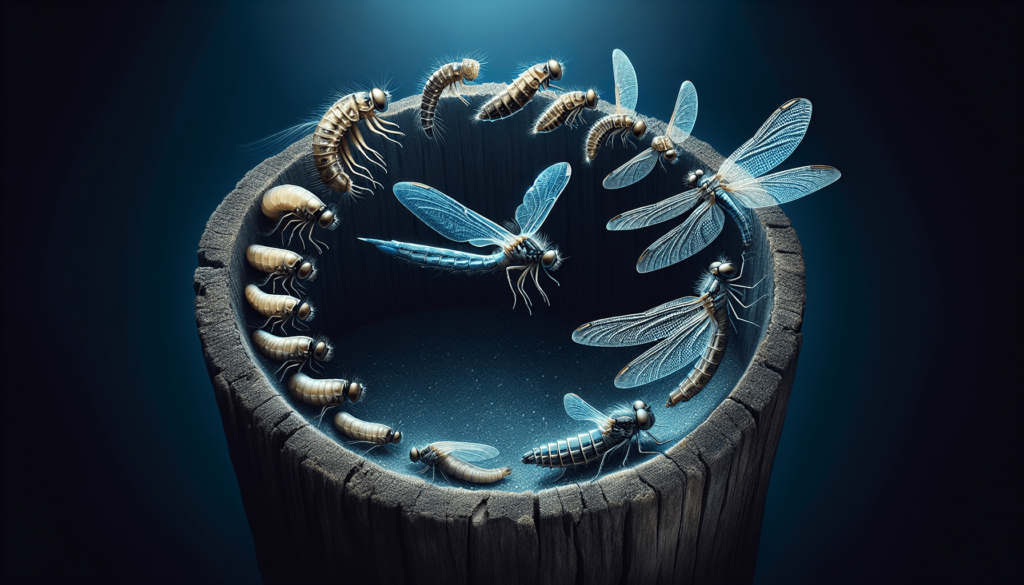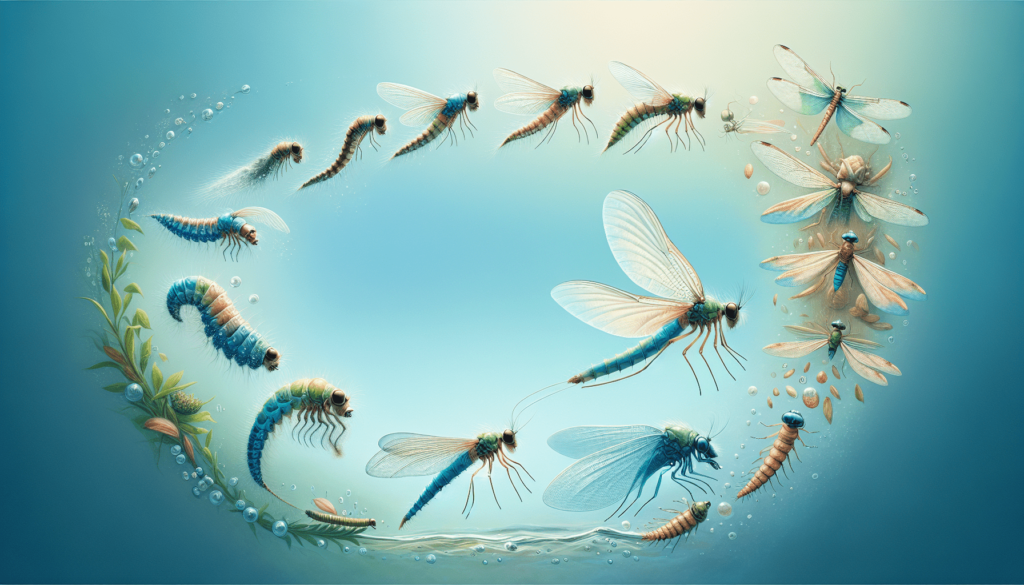
Have you ever wondered about the fascinating life cycle of mayflies? These delicate creatures, commonly found near bodies of water, undergo a remarkable transformation from egg to adult. From their brief but beautiful existence as nymphs in the water, to their short-lived yet enchanting flight as adults, the life cycle of mayflies is truly captivating. Join us as we explore the stages these remarkable insects go through and unravel the mysteries of their existence. So, let’s embark on this journey and discover the incredible life cycle of mayflies together!
The Stages of a Mayfly’s Life Cycle
Mayflies, also known as ephemeropterans, are fascinating insects with a unique and intriguing life cycle. Their life cycle consists of three distinct stages: the egg stage, nymph stage, and adult stage. Each stage is crucial to the survival and continuation of the species.
Egg Stage
The life cycle of a mayfly begins with the egg stage. During this stage, adult mayflies, also known as imagoes, lay their eggs on or near the water’s surface. The eggs are often attached or deposited on vegetation, rocks, or other structures close to the water. This is a critical stage as the survival of the species depends on successful egg-laying.
Egg Laying
Mayflies go through their egg-laying process by releasing their eggs directly into the water. They do this by hovering or dipping their abdomen into the water, allowing the eggs to drop or stick to the desired location. The number of eggs laid can vary depending on the species, but it is not uncommon for a single female to produce hundreds or even thousands of eggs.
Hatching Time
After the eggs are laid, they undergo a period of incubation before hatching into nymphs. The hatching time can vary depending on various factors such as temperature, water quality, and species-specific characteristics. Typically, it takes a few weeks for the eggs to hatch, but this duration may be longer or shorter depending on the environmental conditions.

Nymph Stage
Once the eggs hatch, the next stage in the mayfly’s life cycle begins – the nymph stage. Mayfly nymphs are aquatic insects that live and develop in freshwater ecosystems such as rivers, lakes, and streams. They spend the majority of their lives in this stage, which can last from a few months to several years.
Nymph Growth
During the nymph stage, mayflies go through a series of molts as they grow and develop. They shed their exoskeletons multiple times, allowing their bodies to adapt and accommodate their increasing size. Each molt, or instar, brings the nymph closer to adulthood. Some mayfly species have a rapid growth rate, while others may take longer to reach maturity.
Feeding Habits
Mayfly nymphs are voracious feeders and play a crucial role in freshwater ecosystems. They have specialized mouthparts that enable them to feed on algae, detritus, and other small aquatic organisms. Their feeding habits contribute to nutrient cycling, helping to maintain the ecological balance in their habitats.
Duration
The duration of the nymph stage varies greatly among mayfly species. Some species spend only a few months as nymphs, while others may remain in this stage for several years. The length of the nymph stage is influenced by factors such as species-specific characteristics, environmental conditions, and food availability.
Adult Stage
After completing their growth and development as nymphs, mayflies enter the final stage of their life cycle – the adult stage. This stage is characterized by the emergence of the fully developed and winged adult mayflies from the water.
Emergence
The emergence of adult mayflies from the water is a remarkable sight to behold. It is during this process that the nymphs transform into their adult form by shedding their nymphal skin and developing wings. The emergence can occur on the water’s surface or on nearby vegetation, depending on the species. Once the adult emerges, it needs to dry its wings before it can fly.
Reproduction and Mating
The primary purpose of the adult stage is reproduction and mating. Adult mayflies have a short lifespan, usually ranging from a few hours to a few days. During this time, they focus on finding mates and reproducing. Mayflies have a unique mating behavior known as a mating swarm, in which individuals gather in large numbers to mate.
Life Span
The life span of adult mayflies is relatively short but varies among different species. Factors such as environmental conditions, food availability, and species-specific characteristics can influence the duration of the adult stage. While some mayflies live for only a few hours, others may survive for a couple of days before completing their life cycle.

Factors Affecting Mayfly Life Cycle
Several factors can significantly impact the life cycle of mayflies. These factors include environmental conditions, predators, and human impacts.
Environmental Conditions
Environmental conditions, such as water temperature, sunlight exposure, and water quality, play a significant role in the development and survival of mayfly eggs, nymphs, and adults. Changes in these conditions, whether natural or human-induced, can disrupt the life cycle and population dynamics of mayflies.
Predators
Mayflies face a multitude of predators throughout their life cycle. Nymphs are vulnerable to predation by fish, amphibians, birds, and other aquatic invertebrates. As adults, mayflies become prey for birds, bats, and other insects. Predation pressure can influence the abundance and distribution of mayfly species.
Human Impacts
Human activities, such as pollution, habitat destruction, and water pollution, can have detrimental effects on mayfly populations. Alterations to their habitats, such as the removal of vegetation or the introduction of pollutants, can disrupt the delicate balance necessary for their survival. Conservation efforts and sustainable practices are essential to protect mayflies and their habitats.
Importance of Mayfly Life Cycle
Mayflies play a crucial role in freshwater ecosystems and serve as indicators of environmental health. Their life cycle has several ecological and environmental significance.
Ecological Role
Mayflies contribute to the nutrient cycling in freshwater ecosystems. As nymphs, they help regulate algal populations by feeding on them. When they emerge as adults, they provide a source of food for various predators, thus contributing to the overall food web of the ecosystem.
Indicator Species
Due to their sensitivity to environmental changes, mayflies are often used as indicators of water quality. Their presence or absence can provide valuable insights into the health of aquatic ecosystems. Monitoring mayfly populations can help assess the impact of pollution and other human-induced stressors on freshwater environments.
Life Cycle Adaptations
Mayflies have evolved various adaptations to enhance their survival and reproductive success.
Short Adult Life Span
The short adult life span of mayflies is an adaptation that ensures efficient reproduction and prevents resource competition within the population. By having a brief period as adults, mayflies can focus on mating and reproducing rather than allocating resources to prolonged survival.
Mass Emergence
Mayflies have a remarkable adaptation called mass emergence. By synchronizing their emergence, the adult mayflies increase their chances of successful mating and reproduction. Mass emergences create swarms, which provide a higher likelihood of finding suitable mates within a relatively short period.
Synchronized Mating
Mayflies exhibit synchronized mating behavior, where individuals gather in large groups called mating swarms. This behavior increases the probability of finding mates and enhances reproductive success. Synchronized mating is an adaptation that helps overcome the brief duration of the adult stage.
Lifespan of Different Mayfly Species
The lifespan of mayflies can vary significantly among different species. Factors such as the habitat, environmental conditions, and species-specific characteristics influence the duration of each life stage.
Variations in Duration
Some mayfly species have a relatively short life cycle, with the entire process taking just a few weeks. Others may have an extended life cycle, spanning several years. These variations in duration contribute to the overall biodiversity and dynamics of mayfly populations.
Research and Study of Mayfly Life Cycle
The study of mayfly life cycles has great scientific significance. Researchers use mayflies as model organisms to understand various ecological concepts and processes. By studying their life history, researchers can gain insights into biodiversity, species interactions, population dynamics, and the impacts of environmental change.
Scientific Significance
Mayflies are useful indicators of environmental health and can provide valuable information about freshwater ecosystems. Scientists can monitor mayfly populations to assess the impacts of pollution, habitat degradation, and climate change on aquatic environments. Additionally, they can contribute to the development of conservation strategies to protect mayflies and their habitats.
Conclusion
The life cycle of mayflies is a remarkable process that encompasses three distinct stages – the egg stage, nymph stage, and adult stage. Each stage plays a crucial role in the survival and continuity of mayfly species. Factors such as environmental conditions, predators, and human impacts can significantly affect their life cycle. Mayflies have unique adaptations, such as short adult life spans, mass emergence, and synchronized mating, which enhance their reproductive success. The study of mayfly life cycles has scientific significance and provides insights into ecological processes, environmental health, and conservation efforts. As we continue to learn more about mayflies and their life cycles, we deepen our understanding of the intricate web of life in freshwater ecosystems.